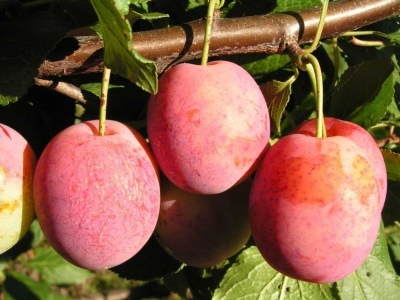
- Authors: United Kingdom
- Name synonyms: Prunus domestica Viktoriya, Koshe Victoria
- Growth type: medium-sized
- Crown: sprawling, sparse, rounded
- Tree height, m: 2,5-3
- Fruit size: large
- Fruit weight, g: 40-45
- Fruit shape: oval-elongated
- Fruit color: violet-red, with a thick waxy bloom
- Skin : thick, dense, durable, hard to peel off
Victoria plum is also called in another way: Queen Victoria, Prunus domestica Viktoriya, Koshe Victoria. This variety is one of the most widespread, it was twice awarded the "Merit of the Garden" award (1993, 2013).
Breeding history
The history of the origin of the Victoria plum is mysterious. Great Britain is considered to be the homeland of this variety. There is a version that this is a self-seeder, which was found in the county of Alderton in the town of Sussek. However, geographers claim that such a town has never existed in this place. The name has been assigned to the variety since 1844.
Description of the variety
Victoria Plum is considered a profitable industrial export variety. It perfectly pollinates other varieties of domestic plums with medium ripening times.
Fruit characteristics
The fruits have an ovoid, rounded-obtuse shape at both poles. They are quite large (up to 45 g), however, with an excessive abundance of the crop, they can become smaller (up to 28 g). The pale golden skin is thick and dense and not easy to remove. On the sunny side, the fruit turns wine-red, on which white and gray-rusty subcutaneous dots in bright red rings are clearly visible. The whole fruit is fluffed with a violet-red tint with a thick waxy bloom.
There is a small abdominal suture. It is very deep with thick edges and divides the fruit into two halves that differ in size.
Very juicy delicate pulp of orange-golden color of rather dense consistency. The stone is large, it is separated only after the plum is fully ripe. The fruits have a pronounced aroma.
Taste qualities
The taste of ripe plums is sweet, with a slight sourness. In favorable seasons, at full maturity, the taste has the advantages of a table variety. A damp climate has a beneficial effect on improving the palatability.
The flavor reaches its peak when the fruit is at its darkest color. During this period, the sugar content in the fruits increases significantly, which improves their taste for fresh use.
The tasting score is 4.2 points.
With drought and coolness, the taste deteriorates somewhat. If the tree is overloaded with harvest, then the pulp also loses its quality characteristics, becoming tasteless.
Ripening and fruiting
This variety is fast-growing. The crop can be harvested as early as the third year after planting. The plum blooms in May, and the fruits ripen by the end of August, in September.

Yield
The yield of the variety is high. On average, up to 50 kg of plums are removed from an adult tree.
Growing regions
This variety has proven itself well in the territories of the Baltic States, Belarus, and Ukraine.
Growing and caring
Planting seedlings requires fertile, loose soil that is pH neutral.
The distance between seedlings should be at least 4 meters.
The lighting of the site does not have strict restrictions, since the tree is sun-loving, but shade-tolerant. On the sunny side, fruit ripening will be faster.
In case of drought, watering of the tree is required.
From 12-15 years old, the tree needs regular anti-aging pruning.
In winter, under a snow cover, the tree tolerates low temperatures quite well, and during snowless frosty winters, young plantings need to be insulated.




Disease and pest resistance
The tree has an average resistance to disease. Cold and rainy weather is especially dangerous for him - a time favorable for the development of fungal diseases. The increased humidity causes fruit rot, which can destroy the entire crop in a few days.

Despite the fact that plum is considered more hardy than many fruit trees, it is not immune from diseases. It is attacked by viral, fungal and bacterial infections, and parasitic insects harm it. It is necessary to notice and recognize the signs of plum disease in time. They are easier to deal with and defeat early on. Well, in order to protect the garden tree from such a misfortune in the future, preventive procedures can be carried out.

Review overview
As positive characteristics, gardeners note the good transportability of the Victoria plum: within 8 days it does not lose its presentation. It is important that the fruits do not crumble, do not crack, and have a high-quality taste. Plum is ideal for all culinary and drying dishes.
Its disadvantage is noted - the possibility of fungal diseases.


































































